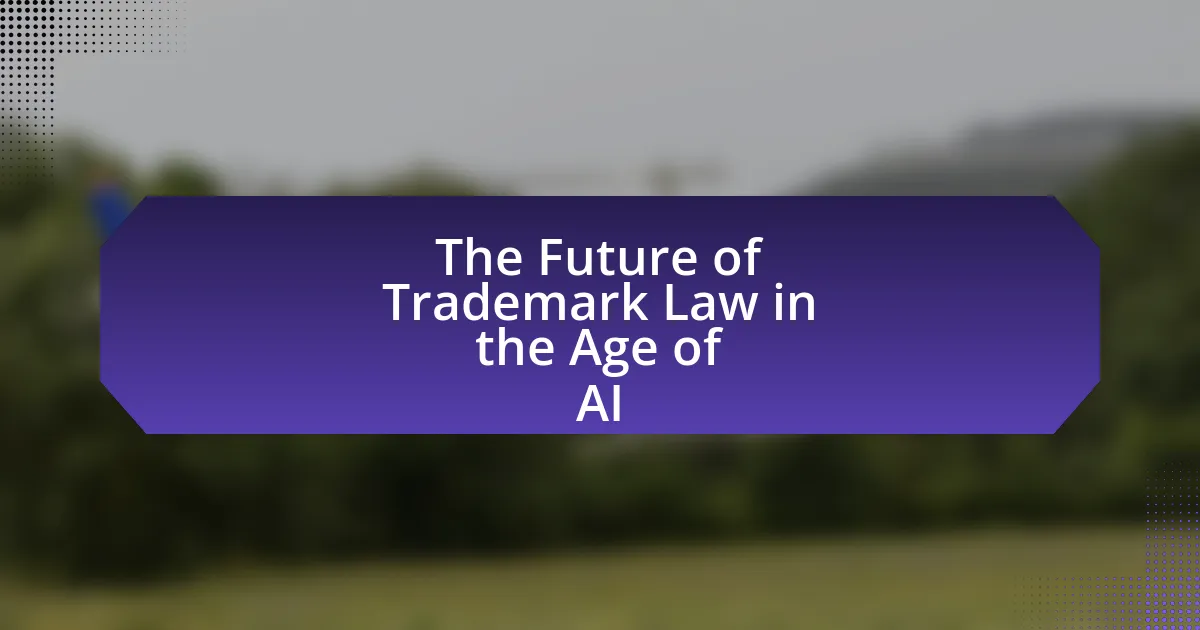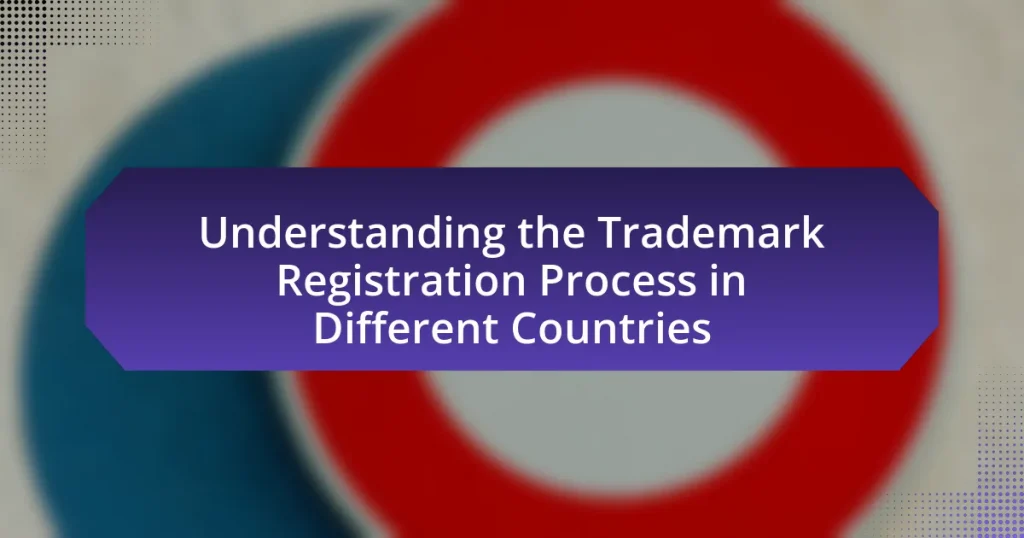The article examines the future of trademark law in the context of rapidly advancing artificial intelligence (AI) technologies. It highlights the complexities introduced by AI in protecting intellectual property, including challenges related to originality, ownership, and trademark infringement. Key topics include the influence of AI on trademark registration processes, the efficiency of AI-driven trademark searches and monitoring, and the implications of AI-generated trademarks. The article also addresses the challenges trademark law faces due to AI, the potential benefits of integrating AI into trademark management, and strategies for stakeholders to navigate this evolving landscape.

What is the Future of Trademark Law in the Age of AI?
The future of trademark law in the age of AI will likely involve increased complexity in protecting intellectual property due to the rapid advancement of AI technologies. As AI systems generate content and brands, the potential for trademark infringement rises, necessitating clearer guidelines and regulations. For instance, AI-generated logos or names may lead to disputes over originality and ownership, prompting legal frameworks to adapt to these new challenges. Additionally, the use of AI in trademark searches and monitoring can enhance the efficiency of identifying potential infringements, but it also raises questions about the reliability of AI in making legal determinations. As a result, trademark law will need to evolve to address these issues, balancing innovation with the protection of brand integrity.
How is AI influencing the current landscape of trademark law?
AI is significantly influencing the current landscape of trademark law by enhancing the efficiency of trademark searches and monitoring. Advanced algorithms can analyze vast databases of trademarks, identifying potential conflicts and similarities more quickly than traditional methods. For instance, AI tools like TrademarkNow and Markify utilize machine learning to provide real-time insights into trademark registrations, helping businesses avoid infringement and streamline the application process. This technological advancement not only reduces the time and cost associated with trademark searches but also increases the accuracy of identifying potential legal issues, thereby shaping a more proactive approach to trademark management.
What are the key changes in trademark registration processes due to AI?
The key changes in trademark registration processes due to AI include enhanced search capabilities, automated application reviews, and improved monitoring of trademark use. AI technologies enable more efficient and accurate searches of existing trademarks, reducing the likelihood of conflicts and improving the quality of applications. Automated systems can analyze applications for compliance with legal standards, expediting the review process. Additionally, AI tools facilitate ongoing monitoring of trademarks in the marketplace, allowing for quicker identification of potential infringements. These advancements are supported by data showing that AI can significantly reduce processing times and increase the accuracy of trademark assessments.
How does AI impact trademark infringement cases?
AI significantly impacts trademark infringement cases by enhancing the ability to detect and analyze potential infringements through advanced algorithms and machine learning techniques. These technologies can quickly scan vast amounts of data, including online content and social media, to identify unauthorized use of trademarks. For instance, AI tools can analyze patterns in consumer behavior and assess the likelihood of confusion between similar trademarks, which is a critical factor in infringement cases. Additionally, AI can assist in automating the trademark registration process, making it more efficient and reducing the likelihood of human error. The use of AI in these contexts is supported by studies showing that machine learning models can achieve high accuracy rates in identifying trademark violations, thus providing a robust framework for legal analysis in trademark law.
What challenges does trademark law face with the rise of AI?
Trademark law faces significant challenges with the rise of AI, primarily due to issues of originality and infringement. AI systems can generate content that closely resembles existing trademarks, leading to potential confusion among consumers and complicating the determination of trademark ownership. For instance, AI-generated logos or brand names may unintentionally infringe on established trademarks, raising questions about liability and enforcement. Additionally, the speed at which AI can create and disseminate content outpaces traditional trademark registration processes, making it difficult for trademark owners to protect their rights effectively. These challenges necessitate a reevaluation of existing trademark laws to address the unique complexities introduced by AI technologies.
How does AI complicate the determination of trademark similarity?
AI complicates the determination of trademark similarity by introducing advanced algorithms that can analyze and generate brand names, logos, and marketing materials in ways that may not align with traditional legal frameworks. These algorithms can create new trademarks that are visually or phonetically similar to existing ones, making it challenging for legal professionals to assess potential conflicts. Additionally, AI’s ability to learn from vast datasets can lead to the emergence of novel combinations that may not have been previously considered, further blurring the lines of similarity. This complexity necessitates a reevaluation of existing trademark laws to accommodate the rapid evolution of branding facilitated by AI technologies.
What are the implications of AI-generated trademarks?
AI-generated trademarks raise significant legal and ethical implications, particularly concerning originality and ownership. The primary concern is whether these trademarks can be considered unique and non-infringing, as AI systems often learn from existing data, potentially leading to unintentional similarities with pre-existing trademarks. This situation complicates the assessment of trademark distinctiveness, a key requirement for registration and protection under trademark law. Furthermore, the question of who holds the rights to an AI-generated trademark—whether it is the developer of the AI, the user, or the AI itself—remains unresolved, creating uncertainty in intellectual property rights. Legal frameworks may need to adapt to address these challenges, as traditional concepts of authorship and creativity do not easily apply to AI-generated outputs.

What are the potential benefits of integrating AI into trademark law?
Integrating AI into trademark law can enhance efficiency, accuracy, and accessibility in trademark searches and registrations. AI algorithms can analyze vast databases of trademarks quickly, identifying potential conflicts and similarities that human examiners might overlook. For instance, a study by the World Intellectual Property Organization (WIPO) highlighted that AI tools can reduce the time required for trademark searches by up to 80%, significantly expediting the registration process. Additionally, AI can assist in monitoring trademark usage across digital platforms, helping to detect infringements in real-time, which is crucial for brand protection. These capabilities not only streamline legal processes but also improve the overall effectiveness of trademark enforcement.
How can AI improve trademark search and monitoring?
AI can improve trademark search and monitoring by enhancing the accuracy and efficiency of identifying potential conflicts and infringements. Machine learning algorithms can analyze vast databases of existing trademarks, enabling quicker searches and more precise results. For instance, AI can utilize natural language processing to interpret variations in trademark applications, identifying similar marks that may not be immediately obvious to human examiners. Additionally, AI-driven monitoring tools can continuously scan the market for new applications and uses of trademarks, alerting businesses to potential infringements in real-time. This capability significantly reduces the risk of costly legal disputes and enhances brand protection strategies.
What tools are available for AI-driven trademark searches?
AI-driven trademark searches can be conducted using tools such as TrademarkNow, Markify, and CompuMark. TrademarkNow utilizes machine learning algorithms to analyze trademark databases and provide instant search results, significantly reducing the time required for traditional searches. Markify offers comprehensive trademark monitoring and search capabilities, leveraging AI to identify potential conflicts and similar marks. CompuMark combines AI with extensive trademark data to deliver insights and analytics for trademark clearance and monitoring. These tools enhance the efficiency and accuracy of trademark searches, supporting legal professionals in navigating the complexities of trademark law in the digital age.
How does AI enhance the efficiency of trademark litigation?
AI enhances the efficiency of trademark litigation by automating the analysis of trademark databases and legal documents, significantly reducing the time required for research and case preparation. For instance, AI algorithms can quickly identify potential conflicts by scanning millions of trademarks and related cases, which traditionally would take legal professionals extensive hours to accomplish. This capability not only accelerates the litigation process but also increases accuracy in identifying relevant precedents and potential infringements, thereby improving the overall effectiveness of legal strategies.
What role does AI play in trademark enforcement?
AI plays a significant role in trademark enforcement by automating the detection of potential infringements and streamlining the monitoring of trademark usage across various platforms. Advanced algorithms analyze vast amounts of data, identifying unauthorized use of trademarks in real-time, which enhances the efficiency of enforcement actions. For instance, AI tools can scan social media, e-commerce sites, and other digital spaces to flag instances of trademark violations, allowing companies to respond swiftly. This capability is supported by studies showing that AI can improve the accuracy of infringement detection by up to 90%, significantly reducing the time and resources traditionally required for manual monitoring.
How can AI assist in identifying counterfeit goods?
AI can assist in identifying counterfeit goods by utilizing advanced machine learning algorithms to analyze product images and packaging for inconsistencies. These algorithms can detect subtle differences in logos, colors, and materials that may not be visible to the human eye. For instance, a study published in the journal “Nature” demonstrated that AI systems could achieve over 90% accuracy in distinguishing between genuine and counterfeit luxury goods by analyzing visual features. Additionally, AI can process vast amounts of data from online marketplaces to identify suspicious patterns and flag potential counterfeit listings, enhancing the efficiency of detection efforts.
What are the limitations of AI in trademark enforcement?
AI has limitations in trademark enforcement primarily due to its inability to fully understand context and nuances in language and imagery. For instance, AI systems may struggle with distinguishing between similar trademarks that differ in subtle ways, leading to potential misclassifications. Additionally, AI lacks the capability to interpret the intent behind trademark use, which is crucial in determining infringement. Furthermore, AI systems can be biased based on the data they are trained on, potentially overlooking important variations in trademark applications across different jurisdictions. These limitations highlight the necessity for human oversight in trademark enforcement to ensure accurate and fair assessments.

How can stakeholders prepare for the future of trademark law in the age of AI?
Stakeholders can prepare for the future of trademark law in the age of AI by actively engaging in policy discussions and adapting their strategies to incorporate AI technologies. This involves staying informed about emerging AI-related legal precedents and participating in industry forums to influence regulatory frameworks. For instance, the World Intellectual Property Organization (WIPO) has been exploring the implications of AI on intellectual property rights, highlighting the need for stakeholders to understand how AI can affect trademark registration and enforcement. By collaborating with legal experts and technology developers, stakeholders can ensure that their trademark practices remain compliant and effective in a rapidly evolving landscape.
What strategies should businesses adopt to navigate AI-related trademark issues?
Businesses should adopt proactive trademark registration and monitoring strategies to navigate AI-related trademark issues. By registering trademarks early, companies can establish legal rights and prevent potential infringements from AI-generated content. Additionally, implementing robust monitoring systems allows businesses to detect unauthorized use of their trademarks in AI outputs, enabling timely legal action. Research indicates that companies with active trademark management experience fewer disputes and maintain stronger brand integrity, as seen in a study by the International Trademark Association, which highlights the importance of vigilance in trademark protection in the digital age.
How can companies leverage AI tools for trademark management?
Companies can leverage AI tools for trademark management by utilizing automated monitoring systems that track trademark usage and potential infringements across various platforms. These AI systems analyze vast amounts of data, including social media, e-commerce sites, and domain registrations, to identify unauthorized use of trademarks. For instance, a study by the World Intellectual Property Organization (WIPO) highlighted that AI can significantly reduce the time and resources needed for trademark searches and monitoring, enhancing efficiency in protecting intellectual property. By implementing AI-driven analytics, companies can proactively manage their trademarks, ensuring compliance and safeguarding their brand identity in a rapidly evolving digital landscape.
What best practices should legal professionals follow in the AI era?
Legal professionals should prioritize continuous education and ethical considerations in the AI era. Continuous education ensures that legal practitioners stay updated on AI technologies and their implications for law, particularly in areas like trademark law where AI can influence case outcomes and legal strategies. Ethical considerations involve understanding the biases inherent in AI systems and ensuring that their use does not compromise client confidentiality or lead to unjust outcomes. For instance, a study by the American Bar Association highlights the importance of ethical guidelines in the adoption of AI tools, emphasizing that legal professionals must critically assess AI outputs to maintain the integrity of legal practice.
What are the key takeaways for trademark practitioners in the age of AI?
Trademark practitioners must adapt to the evolving landscape shaped by AI technologies, focusing on the implications for trademark registration, enforcement, and litigation. AI can streamline the trademark search process, enabling practitioners to conduct more efficient clearance searches and identify potential conflicts with existing marks. Additionally, AI tools can assist in monitoring trademark use across digital platforms, enhancing enforcement efforts against infringement. Practitioners should also be aware of the challenges AI poses, such as the potential for increased trademark disputes arising from AI-generated content and the need for clear guidelines on ownership and rights related to AI-created trademarks. Understanding these dynamics is crucial for effective practice in the current environment.
How can trademark practitioners stay updated on AI developments?
Trademark practitioners can stay updated on AI developments by regularly engaging with industry publications, attending relevant conferences, and participating in professional organizations focused on intellectual property and technology. Industry publications such as the World Intellectual Property Organization’s reports and journals provide insights into the latest trends and legal implications of AI. Conferences like the International Trademark Association’s Annual Meeting offer networking opportunities and discussions on emerging technologies. Additionally, organizations such as the American Intellectual Property Law Association often host webinars and workshops that cover advancements in AI and their impact on trademark law. These resources ensure that practitioners remain informed about the evolving landscape of AI and its implications for trademark practices.
What resources are available for learning about AI in trademark law?
Resources available for learning about AI in trademark law include academic journals, online courses, and legal databases. Academic journals such as the “Harvard Journal of Law & Technology” and the “Stanford Technology Law Review” publish articles that explore the intersection of AI and trademark law. Online platforms like Coursera and edX offer courses on AI and intellectual property, providing structured learning. Legal databases such as Westlaw and LexisNexis contain case law and articles specifically addressing AI’s impact on trademark issues, ensuring access to up-to-date legal information.



